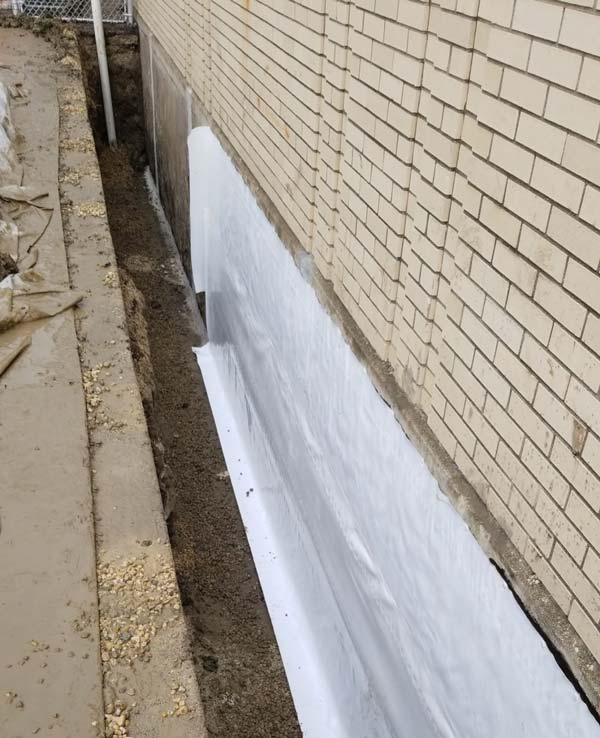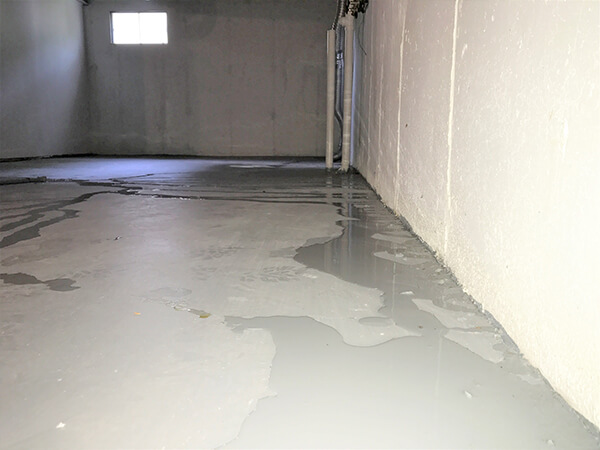The 5 Best Water Solutions for Wet Basement Problems
Wiki Article
Just How Basement Waterproofing Works: A Comprehensive Overview for Your Home
Basement waterproofing is vital for protecting homes from water damages. Numerous techniques exist to resolve dampness problems, each tailored to specific reasons. Homeowners have to recognize these options to pick the most effective remedy for their demands - Exterior Drainage Solutions. The efficiency of these approaches depends on the ideal products and strategies. What are the most usual strategies, and exactly how can they be applied successfully? This overview will certainly check out these important facetsRecognizing the Reasons For Basement Wetness
Although cellars are typically designed to be functional and dry areas, they can come down with moisture because of numerous factors. One key cause is bad water drainage around the structure, which can cause water pooling and seepage. Additionally, hefty rainfall or fast snowmelt can bewilder drainage systems, worsening dampness concerns. Another significant element is the natural moisture present in the ground, which can permeate via floorings and walls, particularly in older homes with less effective barriers. Cracks in the structure might additionally allow water invasion, specifically throughout durations of heavy rainfall. Pipes leakages within the basement can contribute to moisture build-up, developing a setting favorable to mold and mildew development. Ultimately, poor ventilation can catch humidity, aggravating the total wetness issue. Understanding these causes is essential for property owners seeking efficient remedies to stop cellar dampness concerns.Kinds of Basement Waterproofing Methods
Cellar waterproofing methods are important for shielding homes from dampness damage and keeping a safe living setting. These approaches can be extensively classified into indoor and exterior remedies. Inside waterproofing generally involves the installation of drainage systems, sump pumps, and vapor barriers. These systems work to draw away water away from the basement and prevent wetness from permeating through the walls or floor.On the various other hand, outside waterproofing focuses on protecting against water from going into the home in the starting point. This can include excavation around the foundation, using waterproof layers, and setting up drainage tiles to redirect water away from the framework. Additionally, some house owners might go with a combination of both indoor and exterior approaches to guarantee comprehensive defense. Ultimately, the selection of waterproofing method relies on the certain conditions of the home and the level of wetness present in the cellar.Materials Utilized in Waterproofing Solutions

Various products are utilized in waterproofing services to improve the efficiency of both external and indoor methods. Frequently utilized materials consist of liquid membranes, which create a seamless barrier versus wetness. These membranes are usually made from polyurethane or rubberized asphalt, offering versatility and toughness. Furthermore, cementitious waterproofing items are preferred for their simplicity of application and solid adhesion to surfaces.For exterior applications, materials such as drain boards and geotextiles work in rerouting water far from structures. Squashed rock and gravel are likewise made use of in drain systems, promoting correct water flow and decreasing pressure buildup. Sometimes, specialized sealers and coverings, like silicone or epoxy, are related to provide added defense against water infiltration. Together, these materials play a necessary duty in guaranteeing that a cellar remains completely dry and protected from water damages.
Actions to Waterproof Your Cellar
Waterproofing a basement entails a methodical strategy to successfully protect against water intrusion and damage. The very first step is to examine the exterior of the home, looking for splits or gaps in the foundation. These need to be secured with an appropriate water-proof sealant. Next off, confirm that downspouts and gutters are operating correctly and directing water far from the foundation.After addressing outside problems, the interior must be evaluated. Mounting a water-proof membrane layer on basement walls can offer additional defense. Sump Pump Installation And Replacement. It's likewise suggested to apply a sump pump system to manage any water accumulation.Finally, grading the landscape around the home can help direct water away from the structure, more lowering the danger of water infiltration. By following these actions faithfully, property owners can develop a durable defense versus basement flooding and wetness issuesUpkeep and Avoidance Tips for a Dry Basement
Regular upkeep and positive actions are crucial to making certain a completely dry cellar long after preliminary waterproofing efforts. House owners should consistently evaluate downspouts and gutters, guaranteeing they straight water away from the foundation. It is necessary to keep these clear of debris to avoid overflow. In addition, preserving appropriate grading around the home helps network water far from the structure.Checking for cracks in walls or floorings is crucial, as these can enable wetness seepage. Any recognized cracks ought to be immediately sealed with ideal materials. In addition, setting up a sump pump can provide extra defense against flooding.Humidity levels in the cellar must also be monitored, as high moisture can lead to mold growth. Making use of a dehumidifier can help preserve a comfortable atmosphere. Making sure appropriate air flow in the cellar aids in decreasing wetness buildup, maintaining the honesty of the waterproofing system over time.Often Asked Concerns
The Length Of Time Does Cellar Waterproofing Normally Last?
The long life of cellar waterproofing frequently varies based upon materials and setup top quality. Typically, it can last from 5 to ten years, with some systems possibly sustaining longer if effectively maintained and kept track of over time.Can I Water-proof My Basement Myself?
The specific taken into consideration whether to waterproof their basement individually. While DIY alternatives exist, they require knowledge of products and techniques. Specialist services assure reliable results, frequently surpassing the prospective risks and obstacles related to self-installation.
What Are the Signs of Inadequate Waterproofing?
Signs of inadequate waterproofing include persistent dampness, mold development, stuffy odors, peeling paint, and water stains on floors or walls. Homeowners must deal with these concerns immediately to protect against additional damages and keep a healthy living setting.

Does Basement Waterproofing Increase Home Worth?
Basement waterproofing can boost a home's worth by protecting against water damage and enhancing comfortable space. Possible buyers usually prioritize dry cellars, making waterproofing a beneficial investment that adds to total home allure and bankability.Just How Much Does Basement Waterproofing Expense typically?
The average price of basement waterproofing usually ranges from Water Solutions $1,500 to $5,000, differing based on variables such as project size, technique made use of, and neighborhood market problems. Homeowners need to acquire numerous quotes for accurate price quotes. Basement waterproofing is necessary for shielding homes from water damages. Cellar waterproofing approaches are crucial for securing homes from moisture damage and preserving a safe living atmosphere. These systems work to divert water away from the basement and stop moisture from penetrating via the walls or floor.On the various other hand, exterior waterproofing focuses on stopping water from entering the home in the very first place. The durability of basement waterproofing typically differs based on materials and setup top quality. Cellar waterproofing can boost a home's worth by avoiding water damage and enhancing comfortable area.Report this wiki page